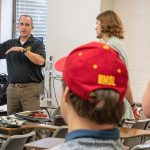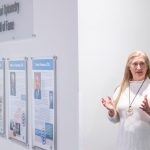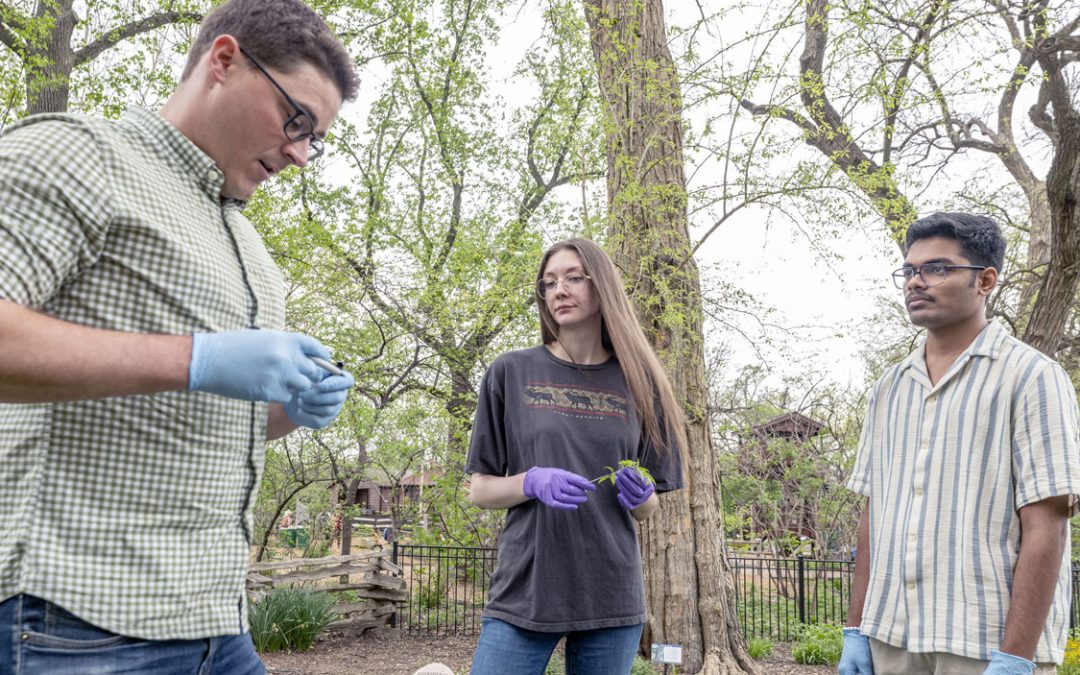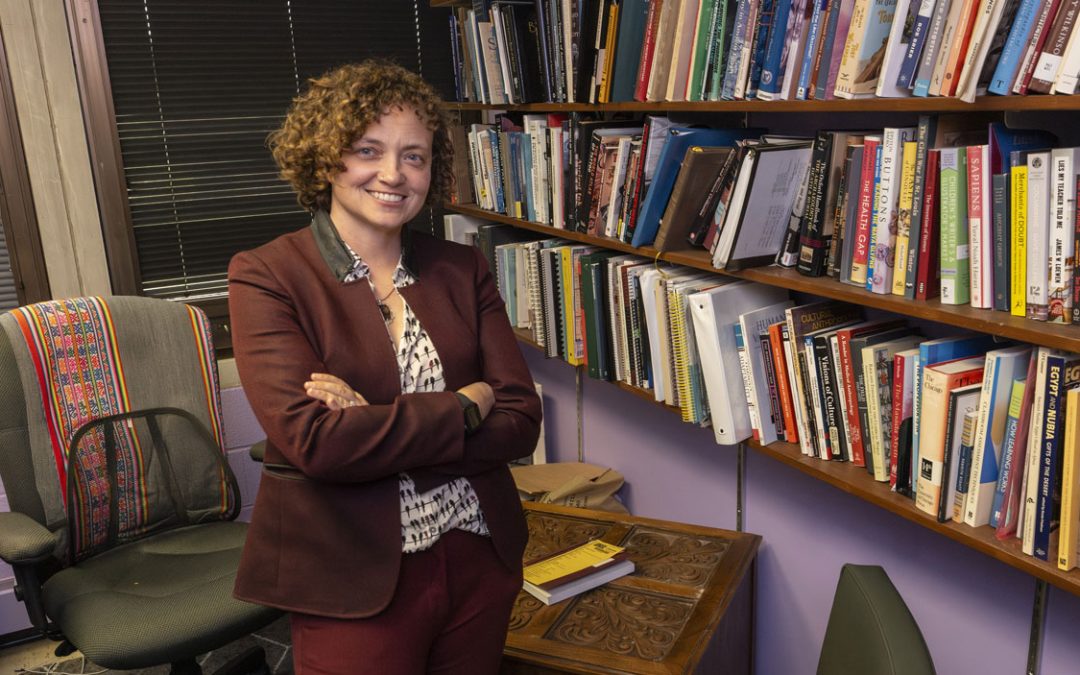
Jesse Core speaks to his fellow DBA graduates, faculty and staff members, along with other guests, at the DBA graduation ceremony at St. Louis Country Club last December. (Photo courtesy of Jesse Core)
As the founder of Scarlet Letter Beverage Company, Jesse Core understands the importance of innovation and adaptability for companies striving to grow in a crowded marketplace.
With his relentless inner drive, Core – a December 2024 graduate of the University of Missouri–St. Louis’ Doctor of Business Administration program – has always tried to not merely keep up or stay slightly ahead of the curve, but to set the pace for the industry in his region of the country.
In 2010, Core founded Core Brewing & Distilling Company, one of the first craft breweries in his home state of Arkansas, and it was a big success. But within a few years, analyzing market trends and research, Core realized the industry was shifting away from craft beer and toward hard seltzer drinks that are lower in calories and carbs and appealed to a growing number of consumers.
By 2018, Core had started the transition to Scarlet Letter Beverage Company and the next year, his revamped production released the first batches of Scarlet Letter hard seltzers, again setting the standard in Arkansas. Sales surged through the COVID-19 pandemic, and the company’s regional footprint continued to increase into 2023, when Core struck a deal with Sam’s Club to produce Member’s Mark Spiked Seltzer. The margins are smaller with private brands, but Core has long been a firm believer that fast nickels beat slow dimes.
That’s just one of the sayings – “Jesse-isms,” they’ve been called – that he uses to ensure his values and motivations are conveyed to and shared by Scarlet Letter employees. Another one: “Quit tripping over pennies to pick up dollars.” Yet another, said with equal parts love and frustration because he’s a Dallas Cowboys fan: “Don’t Romo it.” In other words, after working so hard to get to the goal line, don’t mess up.
There was one specific area that Core found where research was lacking. He had a hunch that if up-and-coming brands such as Scarlet Letter or another emerging brand were allowed more space on a retailer’s mod – the plan for how many facings each product gets on a shelf – that would create more overall sales for the retailer. Unable to find satisfactory research to that end, Core decided to conduct it himself.
And that’s where UMSL’s DBA program entered the picture.
Core, who earned both his bachelor’s and master’s from Harding University in Searcy, Arkansas, wanted to evolve as a strategic leader. He researched doctoral programs with the same vigor and zest he applied to his business decisions, and he quickly noticed the unique approach of UMSL’s DBA program. Conversations with Ekin Pellegrini and Keith Womer, among others, convinced him UMSL was his ideal destination.
“The biggest thing for me is I love the fact that they really value what practitioners think, because I think that’s a significant opportunity in academia,” Core said. “I teach new venture development and strategic management as an adjunct professor at the University of Arkansas, and I communicate this with my colleagues, as well. I truly value the research that’s done in academia, but it’s one thing to read about the challenges of a small business, and it’s a completely different thing when you’ve been in a position where you’re having to decide, how do you make payroll? How do you pivot from a government shutdown? How do you deal with tariffs? Academically, I could say, ‘Well, the answer is this, this, and this.’ But that’s a far different conversation when you’re really dealing with those issues.”
Core started the DBA program in July 2021. Ho Kim, an associate professor of digital and social media marketing, served as his graduate advisor and dissertation chair.
“Jesse came into the program with a very clear research idea. He could actually show that the retailers will benefit from increasing the shelf space for smaller brands, but he didn’t know how to prove that,” Kim said. “That’s how we met and started the research. I pushed him a lot, but he was really good with receiving and accepting every piece of advice that I gave him. His attitude is, ‘I want to learn. I want to improve.’”
Core was able to conduct his research because of the connections he’d made throughout the industry. He reached out to Harps Foods, a chain of grocery stores with 151 locations in Arkansas, Missouri, Oklahoma, Louisiana and Kansas, and gross revenue of over $1 billion.
“Because I’m in the business, I was able to go to them and say, ‘Hey, I’ve got this idea that might be of service to you, gentlemen. Do you want to give it a shot?’” Core said. “That is my advantage. I’m able to go to them, not as an academic, but as somebody in the industry and say, ‘Hey, listen, I’m like you, and I think this is important. You should think this is important. This is not something to help me get published. This is to help our businesses sell more.’”
Because of his relationships – and his reputation – the executives at Harps agreed. Kim said having a doctoral student like Core, with those contacts, is ideal for conducting research that might not otherwise happen.
“That is when the synergy happens,” Kim said. “As professors, we work on research papers on a theoretical, maybe methodological, basis, but in many cases, we don’t have really strong, good industry relationships. But with DBA students who have worked in the industry for a long time, that’s when synergy happens. Field experiments are really expensive. Think about the retailers who participated in an experiment like this. If the experiment actually showed a colossal decrease, that means lost revenue to them, and they don’t want that. Jesse had a very good relationship with retailers, and he was able to convince them to do the experiment.”
The experiment was conducted from January through March 2024. From Feb. 5 to March 3, the number of facings for growth brands was increased, while the number of facings for major brands was decreased by a commensurate amount. In the weeks before and after, the numbers stayed as normal.
“We did a pre-test, post-test, control-group design,” Core said. “We selected 20 stores; half of them were control stores, half of them were stores that were treated – that is, stores whose facings were removed or added. We picked stores in a way that made the treated and control stores very similar. So, for example, one Springdale store was a control store, and one Springdale store was a store where we changed the facings, and then we evaluated the results.”
Core selected three major brands – from White Claw, Truly and Budweiser – and three growth brands – from Scarlet Letter, Boulevard and Mighty Swell. With regression testing, Core and Kim were looking to find if there was an actual impact on sales – both brand- and category-level sales – and if so, what was the impact.
“What we saw was there was a positive correlation, a positive impact by swapping out a big brand for a growth brand,” Core said. “The numbers say that by focusing on these emerging, growing brands, these small brands, it’s not just cute and supporting local and something you can put a cool tag on, it’s good for your business. Giving emerging brands more shelf space boosted total store sales, even when the big brands lost the same amount of space. Surprisingly, the extra sales from the smaller brands didn’t cut into the big brands’ numbers. So, it turned out to be a win-win-win for everyone – the retailer, the emerging brands and the major brands. For me as a business person, I felt like that was the home run.”
Core said the data showed that sales continued to increase post-treatment, too, meaning there was a lasting impact on the total sales category. When consumers became more familiar with the growth brands – because they tried the product when it was given more exposure – they went back and bought the product again.
Core presented his findings to the executives at Harps Foods.
“The best thing I was hoping for was they’d say something like, ‘All right, Jesse, this is really interesting. You gave us some things to think about. Now, we’ll see you later,’” Core said. “That was the best-case scenario. Well, it turns out it was better than that. When I was in that meeting with their president, with their head of marketing and their buyers, they started having some action-oriented dialogue amongst themselves, like, ‘Hey, we really need to look at this. We need to take a closer look at some of our demands, a closer look at our shelf strategy. What if we added more space?’”
Core and Kim are excited to share the results in academic conferences, too.
“We presented his research at various conferences, including the 2025 AMA Winter Academic Conference, which is the American Marketing Association’s academic conference,” Kim said. “We did that this February and again in April, in another conference. Also, we are preparing the research for publication in a journal.”
Safe to say, Core is confident he made the right choice with UMSL’s DBA program.
“I’m grateful for my time at the University of Missouri–St. Louis,” Core said. “I’m certainly an ambassador whenever I get the chance. I’m also a huge fan of Dr. Kim. I think he is a brilliant researcher, and I hope I can do some more work with him in the future.”














